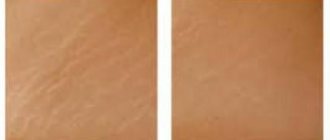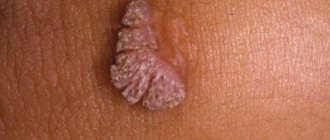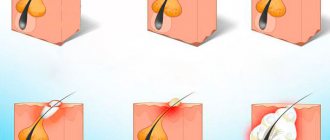Description and causes of stretch marks
Stretch marks on the hips and butt usually do not appear immediately, but gradually. First, the skin in this area begins to turn pink and itch. Then a subcutaneous tear appears, and stripes appear on the skin of the thighs, having convex shapes and red-violet shades.
At this point, removing stretch marks is still quite simple. To do this, you need to choose a treatment that suits your skin. Moreover, it is quite possible to remove these unpleasant manifestations even at home and with inexpensive means.
Over time, stretch marks on the thighs and butt become flat and lighten. They do not tan in the sun, so they are clearly visible against darker skin. The lack of tanning is explained by the fact that melanin is no longer produced on the damaged area of the thigh.
Such old scars cannot be removed using folk remedies. This treatment will only reduce their visibility and give your legs a healthier appearance. How to remove stretch marks on thighs in this case? Only through cosmetic procedures, which are usually performed in salons or clinics.
Most often, stretch marks appear in those parts of the body where the skin stretches well and there are sufficient reserves of subcutaneous fat:
- hips;
- stomach;
- breast;
- small of the back;
- sides;
- shoulders;
- caviar.
The physiological reason for the appearance of stretch marks on the thighs in other places is the insufficient production of elastin and collagen. These substances give the skin the ability to stretch and then return to its normal shape. There are several reasons for the decrease in production, and before you try to remove stretch marks on your thighs, you should figure out why this is happening.
How to deal with stretch marks on your stomach
The most common reasons for decreased production of elastin and collagen are metabolic disorders in the body and hormonal imbalances. The predecessors to this are:
- Excessive production of the hormone progesterone, which negatively affects collagen production. This usually occurs during periods such as pregnancy, puberty and menopause. During these same periods, rapid body growth can be observed, which leads to the appearance of stretch marks on the thighs;
- the use of oral contraceptives or steroids most often leads to hormonal imbalances;
- if there are disturbances in the functioning of the thyroid gland, adrenal glands and other organs of the endocrine system, a hormonal imbalance appears in the body, and this reduces the production of collagen;
- Ehlers-Danlos syndrome, in which the body produces too much collagen. At the same time, body weight increases significantly, and stretch marks are usually darker than usual;
- genetic Morphan syndrome, which is characterized by the presence of a defective gene that negatively affects the condition of connective tissues. With this exposure, these tissues become less elastic;
- excessive production of the hormone cortisol in adolescents. This hormone has a destructive effect on protein, which leads to tissue destruction, including the appearance of stretch marks on the thighs.
Factors that can also trigger the appearance of stretch marks include heredity, rapid weight loss or weight gain, unhealthy and unbalanced diet, and excessive physical activity.
Preventive actions
In order to prevent the appearance of stretch marks, you must adhere to a number of recommendations:
- avoid excessive tanning;
- drink more fluids;
- constantly moisturize the skin with oils and creams;
- massage your skin regularly while taking a bath;
- use body scrubs and peels.
Diet also plays a significant role. It is recommended to consume more plant fiber. The menu should include a sufficient amount of fresh vegetables, fruits, cereals and juices.
How to deal with stretch marks
There are several methods to remove stretch marks on your butt and thighs. But it is worth noting that it will be very difficult to completely remove old scars. This may require long-term and complex treatment.
- Laser therapy. With the help of a special device and fractional lasers, it is possible to significantly reduce most stretch marks, and some can even be removed. To achieve a noticeable effect, you usually need to undergo a course of procedures. The duration of such a course will vary depending on the number of stretch marks on the thighs and butt, as well as on the condition of the skin.
- Mesotherapy. A frequently used method that involves injecting a specially prepared drug under the patient’s skin. The introduction occurs using a roller that has many thin needles. The injected medicine helps to increase the production of elastin and collagen in the area affected.
- Chemical peeling. Substances are applied to the skin in the area of stretch marks that irritate it and promote further death. After this, the processes of restoration and healing are activated. Moreover, healthy skin is restored. The disadvantages of this method of removing stretch marks on the hips and butt are the likelihood of scars and pigmentation at the site of treatment.
- Cosmetic surgery. This technique is used if stretch marks are large or the skin in this area is very sagging. With this technique, sagging skin, subcutaneous fat deposits and stretch marks in this area are removed through surgery.
- Lotions, gels, ointments. All these cosmetics help remove stretch marks on the thighs or butt only at the initial stage of appearance. They can also be used as prophylaxis by women at risk.
Is there a correct professional regimen for getting rid of stretch marks?
Marina Miusova: “At the first stage, we use injection and physiotherapeutic methods - plasma therapy, mesotherapy with peptide regulators and venotonics. The goal is to reduce inflammation in the damaged area and improve microcirculation. This helps avoid the formation of defective collagen.
At the stage of an atrophic scar, it is necessary to tighten the tissue and reduce the width of the scar. For this purpose, soft laser resurfacing, radio wave therapy (thermage, needle RF), injections of collagen, plasma fibrin, polylactic acid, calcium hydroxyapatite, Radiesse are used. If the width of the striae is 8 mm or more, thread methods to bring the edges of the defect together.
Elena Selivanova : “The course usually consists of mesotherapy (low molecular weight hyaluronic acid plus amino acids or peptides) and laser resurfacing (ablative laser or non-ablative - depends on the severity of stretch marks), and then plasma therapy. The laser is done once a month, with injections in between. It may take 5-7-10 cycles of laser and injections - it’s difficult to predict. Flabbiness and unevenness of the skin in the area of stretch marks become smaller, and they themselves become flatter.
Previously, instead of a laser, we did TCA chemical peels, but now we don’t use them, since the damage, unlike lasers, they create is strong and uncontrollable.
Retinol works well - it can be used at home, but only after pregnancy and breastfeeding are completed. Retinol can be taken at 1% from professional brands (Obagi, Rejudicare), or it can be from a pharmacy - for example, klensit, effezel, differin (the chemical is adapalene). Apply for at least 3-6 months.
You can also use dermal rollers with hyaluronic acid or growth factor serums. And reinforcement with collagen stimulants (polylactic acid, calcium hydroxyapatite) - once every 3-4 months, usually 2-3 procedures are needed.”
Tatiana Al Sabunchi : “We use hardware methods related to heating. How it works? Example: I once explained to my son what stretch marks are. She took a plastic bag, stretched it with her fingers, and let go - the bag sagged in this place. My son blew hot air from a hairdryer onto this area and the bag came together. To put it very roughly, this is how hardware methods work on the skin. Thermal methods - resurfacing and radiolifting - promote skin contraction and even out texture.
And yes, sometimes injections are needed into the area of stretch marks (this also applies to scars) - either plasma therapy or mesotherapy, this improves tissue nutrition and regeneration.”
Elena Sibrina : “I note that all these methods are used only when you are no longer pregnant or breastfeeding, and also do not have endocrine pathologies. And I’ll add that sometimes it makes sense to use photo- and bukki-therapy (exposure to Bukki’s borderline X-rays) - if we see excessive growth of blood vessels or suspect that a keloid is forming.”
View this post on Instagram
I - Carnaval de 2022: eu disse não pra um cara e alguns minutos depois, enquanto eu brincava com bambolê, uns amigos dele vieram e ficaram gritando coisas pra mim e uma delas foi: “vamo em casa pra vc limpar lá com esse cabelo de vassoura", faz 2 anos que eu não uso chapinha, demorei 19 anos pra aceitar meu cabelo do jeito que ele é, semana passada deixei ele secar sem nenhum produto. São as pequenas coisas. II - 2006 à 2013: vivi a maior parte da minha vida em manaus, apesar dos 40 graus diários eu não tirava meu casaco pra nada, tudo isso pra não torrar no sol e não escurecer ainda mais a minha pele, passei mal incontáveis vezes e deixei de sair mais ainda. Domingo passado passei 3 horas no sol até, literalmente, queimar. Pequenas coisas. III - O processo de autoaceitação é difícil e demorado mas semana passada eu não passei um produto sequer no meu cabelo, domingo deitei e aproveitei o sol, não lembro quando foi a ultima vez que usei um sutiã e ontem passei glitter nas minhas estrias, são as pequenas coisas.











